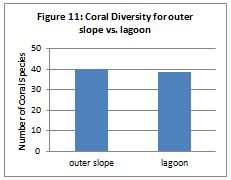BIOT Sciece Expedition 2014 - Dr Doug Fenner’s initial report
Coral Species Diversity and Abundance
Douglas Fenner
This research project recorded coral species and relative abundance at each dive site, plus record some information on coral diseases. This was conducted on a total of 30 dive sites. I began each dive at the lower end of the allowed depth range, approximately 24 meters depth, then spent my dive slowly working my way shallower, ending under the dive boats in about 10 m of water after about 60 minutes. I attempted to photograph all coral species multiple times, and particularly concentrated photography on corals I have not seen before, have not been reported before for Chagos, and/or I cannot identify. I also photographed many diseased corals, particularly those that look different from those I have photographed previously. I took some pictures of scenes, showing what the reef was like, plus some photos of fish or other interesting marine life. I took a total of about 2800 underwater photographs. I collected 30 small samples of corals that I could not identify or to confirm species that I was not sure of for further analysis.
I recorded a total of about 143 species of coral (that number will increase slightly when I examine my photographs), 32 of which have not previously been reported from Chagos, and 16 of which are outside their known ranges. Two previous lists of coral species, one by Sheppard (1999) and the other by Obura, each found about 220 species, but when combined had a total of about 310 species. Veron has reported a total of 275 species, but his sources need confirmation (he has not been to Chagos). I found an average of about 40 coral species per dive site. Previous studies by the author found an average of 35 species per site in Rodrigues, 65 species per site in the Andaman Islands, and 49 per site in SW Madagascar. One species which was first described in 2003, Plerogyra diabolotus, was found which is the first record I am aware of other than the type location which was in Borneo. Also, Parasimplastrea sheppardi was found for the first time in Chagos. It was first found in Oman by C.R.C. Sheppard and is known from the Arabian Peninsula. Also, the author reported it from Rodrigues in 2004. This is the farthest east it has been recorded so far. It may be more widespread in the Indian Ocean.

Blenheim and Paros Banos had the most coral species and Salomon had the least, however the number of sites was small enough that these results are likely not significant. Outer slopes and lagoon sites had the same number of species as shown in figure 10.


Coral diseases were much more common than reported from a survey in 2006. The most common and threatening disease was “white syndrome”. This disease kills coral that it infects, and often kills rapidly. Although it sometimes stops before killing an entire colony, it kills many colonies. It primarily infects tabular Acropora colonies. There were large numbers of tabular Acropora colonies that grew after the 1998 El Niño mass coral bleaching, primarily on the upper reef slope and on patch reefs. Acropora paniculata was the most common table, and A. clathrata was much less common. There are many dead table corals at many sites, which may have been produced by senescence, and/or white syndrome. This disease is throughout the archipelago. A second disease is a tissue loss disease that affects branching corals such as Pocillopora and Stylophora pistillata. It is also widespread in the archipelago and can be lethal for a colony, but is not common enough to have killed large numbers of colonies. Growth anomalies, which have been called “tumours” in the past, are common some other places such as American Samoa on tabular Acropora and massive Porites colonies, but were rare in Chagos. Two types of growth anomaly were seen and photographed for the first time here, but both were extremely rare, being found only in one colony each, out of hundreds or thousands of colonies seen of the coral species they were found on. Three kinds of discoloration were also found, but they were also exceedingly rare.

